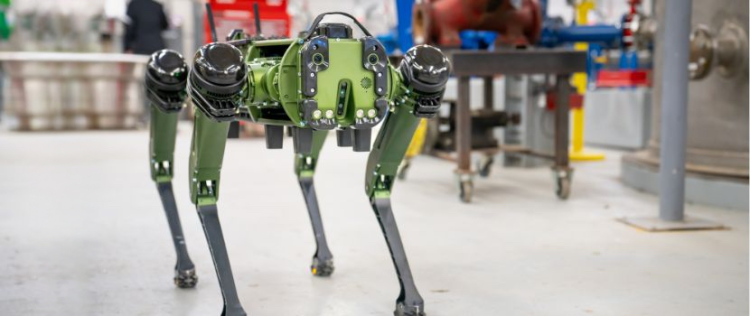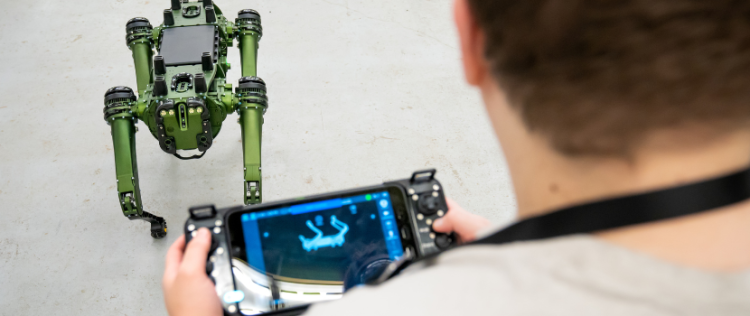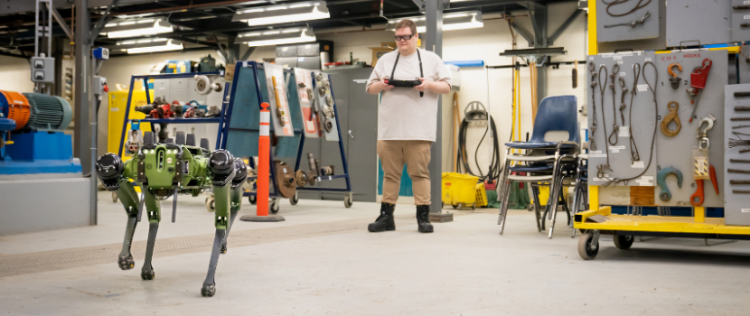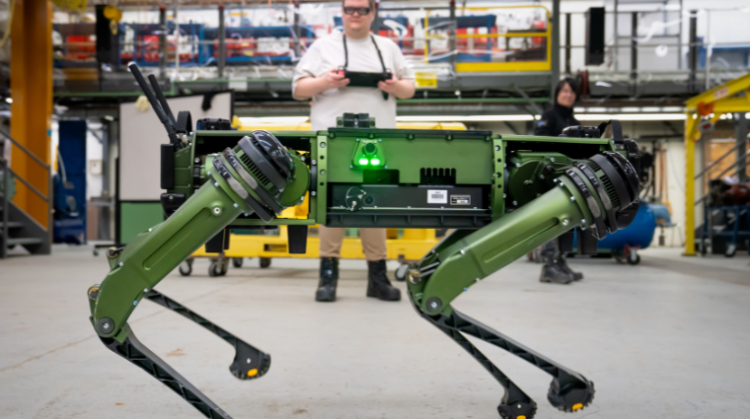Saskatchewan Polytechnic recently purchased a state-of-the-art robotic dog, also known as a quadruped, that can roll over, fetch (with the help of a robotic arm) and navigate hazardous terrain. The quadruped can perform critical tasks such as inspections, surveillance, mapping and security. Sask Polytech's Digital Integration Centre of Excellence (DICE) will use the quadruped for applied research and fee-for-service projects, providing valuable support to Saskatchewan's agriculture, energy, mining and other industries.

Image credit: Saskatchewan Polytechnic
The robotic dog's given name is Vision 60 Q-UGVs, or quadrupedal unmanned ground vehicle. Manufactured by Ghost Robotics of Philadelphia, the quadruped is a durable platform, designed to withstand harsh environments, dust and water immersion. It is equipped with a variety of sensors and radios, all on a relatively simple platform for a robotic dog. The straightforward and stripped-down approach to the base design means that many sensors and attachment packages can be added to the dog's frame, adapting to needs of different field applications or research projects. As with all electric apparatuses, the dog needs to be charged between tasks. Like most people in Saskatchewan, the pup is always well-prepared for the weather and came with an extra pair of rubber booties.
"The quadruped is an autonomous digital sensor/manipulator platform that allows DICE to assist with inspections and mapping, the initial stages of product development and subsequent testing in a variety of unique situations and environments," says Dr. Terry Peckham, DICE director and research chair. "Our quadruped will help Saskatchewan's agriculture, mining and potentially many other industries with digital transformation. The initial cost of digital platforms and tools like the quadruped can be an impediment to organizations. That is where DICE comes in we have the tools, expertise and experience to help businesses with their digital challenges."
The quadruped is an incredibly versatile platform for initial field testing and applied research due to its ability to navigate various environments and terrains. Kelvin Boechler, DICE research manager, shares, "The quadruped is our eyes and ears on the ground. We will be able to view exactly what the quadruped detects through its mobile cameras and sensor platforms. Additionally, if needed, we can issue verbal commands to individuals via a radio attached to the dog."
Having access to the DICE quadruped will allow businesses to conduct proof-of-concept and field trials without the need to invest in unfamiliar technologies. "For instance, it could be used by an agriculture company to test weed eradication using a heat source, demonstrating potential and identifying risks before investing in the technology for themselves," adds Boechler. The quadruped is ideal for hazardous or unsafe locations because it can use cameras, sensors and radios to transmit information back to the user. Its versatility will appeal to industry partners ranging from those in early product or process development, to established industries undergoing digital transformation.
"The quadruped can be used in tandem with other digital technologies such as unmanned aerial vehicle (UAVs) or remote autonomous vehicle operations," says Boechler. "It can be used alongside anything that involves digital sensors or manipulators. DICE has interest from industry to use the quadruped for scanning and sensing in hazardous locations, for safety, emergency response and infrastructure maintenance. The dog also builds capacity to continue our previous research in GPS-denied or limited environments, such as underground mines, tunnels and buildings."
The possibilities of the quadruped for applied research are endless. It could be utilized for asset maintenance or inspection across various transportation, infrastructure and logistics tasks, such as checking runways for foreign objects or surveying extensive rail lines.
Each project DICE undertakes with the quadruped will include involvement from students or recent graduates to give them an opportunity to apply their skills in a hands-on learning environment and gain experience using new equipment.



- All photos of the quadruped were taken in the Industrial Mechanics shop at Saskatoon campus. This is an example of the type of setting the quadruped will work in in the future.
Organizations partnering with DICE gain access to exceptional computational facilities, faculty expertise, student researchers, research and development funding and a vast network of connections. DICE, funded by NSERC and Innovation Saskatchewan, is Saskatchewan's first Technology Access Centre (TAC) and specializes in applied research related to data manipulation, analysis, storage, transmission and display.
Learn more at saskpolytech.ca/dice.













